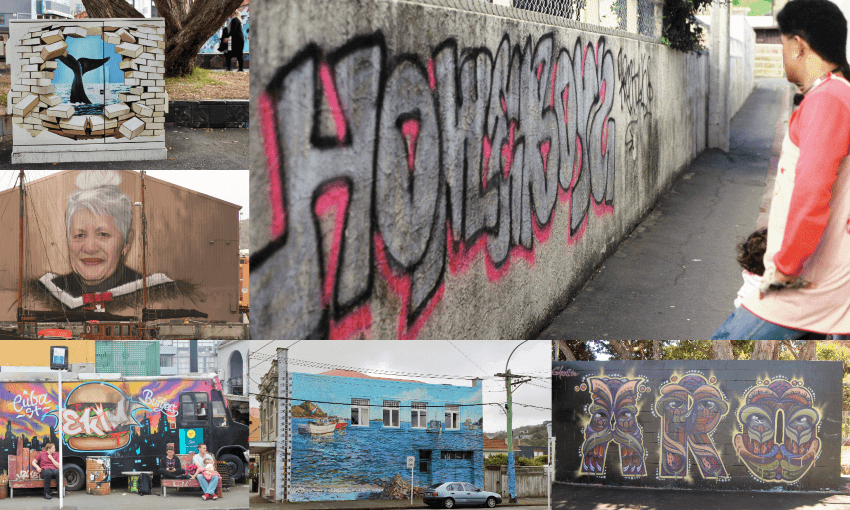Jaimie Baird’s new book Here Today Gone Tomorrow is a record of four decades of graffiti and street art in Wellington, told through more than 1,200 photographs. He spoke with Joel MacManus about what inspired the book.
How did you first get interested in photographing street art?
I remember reading an article in Tu Tangata magazine back in Feburay 1985 about hip hop, which is a subculture that had developed in New York and was starting to emerge in Wellington. I was quite intrigued and wanted to know what it was all about and how it had reached New Zealand. Obviously it included things like breakdancing and rapping, and I read a book about what was called “bombing”‘ – kids going around with spray cans doing murals on trains. I started looking around, and I met a guy named Cosmo in Manners Mall who was right into it. He was a breakdancer, was in the graffiti scene, and had a crew of guts who ran the Uncut Funk show on Radio Active. I used to go hang out with them and photograph some of his work. That expanded to a wider interest in mural art, street art, protest art, and all kinds of messages sprayed on walls.
What was it like interacting with those crews?
You mean, am I too much of a straight laced public servant? [laughs] Yes, I came from a completely different background, probably a more privileged background than some of the people I met, but they were all really nice and really genuine people. At the time, they were often described as criminals, which was ridiculous. But obviously if you’re a property owner whose building got tagged, you’re going to be quite upset.
In the 80s, I set up an organisation through the Uncut Funk show called Club Graffiti, which was intended as an international search for interesting graffiti. I got in touch with a number of bombers through that. I even wrote to David Lange asking if he would like to join Club Graffiti. He kindly responded by pointing out that graffiti is probably vandalism and illegal and said some of his colleagues might be interested, particularly Ann Hercus, the Minister of Police. He obviously had a good sense of humour.
Why did you spend four decades dedicated to this one project?
I don’t know that it was dedication so much as a hobby. It wasn’t some planned thing, but I used to have a camera with me a lot of the time, and when I’d see something and I’d take a photo right there and then, or I’d run home and get the camera. This started well before digital photography, so it was quite an expensive thing to do.
Do you have a favourite piece of street art?
I’m often asked that, and I really couldn’t say. The next piece I see becomes my new favourite. They’re all part of the talk on the street, the social history of the city. Sometimes it’s things you don’t expect. Recently, I photographed some stuff behind Valhalla and I found three words in normal handwriting size: “ADHD Autism Dyslexia”. Somebody had written that because something about it resonated with their life, but nobody would have ever seen it unless you were looking for it.
What have you learned from four decades of photographing street art?
I’ve learned that people have different perspectives, even within themselves. You might write something on a wall, but doesn’t mean that’s the only part of you. That’s just part of humanity, I suppose.
Way back when Mount Vesuvius blew up, it buried the entire city of Pompeii. Archeologists are still uncovering it. On the city walls there was graffiti, vandalism and slogans, which gave them a better understanding of the language and issues of the day. I think it’s quite important that graffiti is recorded. It captures the moment.
I never saw my job as promoting graffiti. I’m not decrying it either, I’m just noting that it is there. That’s why I take these photos, because they’re there. It might be art, or it might be political slogans like “Free Palestine”, but it all tells a story.


